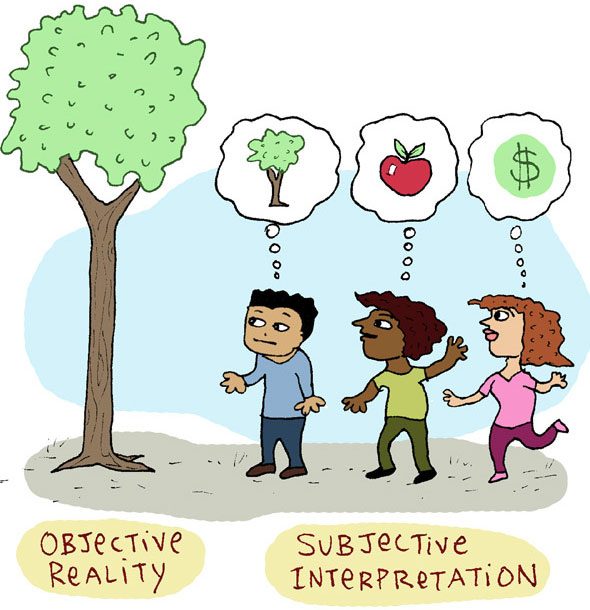Subjective Perception and Orders of Reality – Part 3

In last sentence of Part 2, the teacher concluded with an important concept in Vedanta “orders of reality“. But didn't explain…
Now the inquiring Vedantic student asks, “What do you mean by order of reality? Can reality have orders and differences?”
” We have a personal subjective reality.
When we perceive something… we superimpose values, emotions, preferences and prejudices on things that are themselves just what they are. Nothing less nothing more.
However when we respond with emotions (our individual feelings), the responses are entirely personal in reference to people, objects and situations.
Subjectivity plagues us in the form of likes and dislikes. It confuses our perceptions making us see what is NOT and not see what IS.
All through life our values and emotions make us decide.
But values change.
For example, the time we used to play with marbles as a child, treasuring them as precious. Then age and maturity played their cards. We got over the craze for the coloured balls.
We wonder what we ever saw in those simple pieces of glass.
If we take a rose for instance, some people love this flower. Some others quite indifferent. While there are some who could violently dislike fragrant colourful objects.
But a rose is just as it was made with neither preference nor prejudice.
Meaning the category of Subjectivity includes anytime we mistake an object for another that is not present. Then errors, illusions and delusions come.
The reality of a dream also comes under this category.
When in dull twilight, we see a piece of rope and jump in fright thinking it is a snake; a coiled serpent.
The fear leaves when we realise it was just a rope. Nothing more.
Knowledge released us from the hoax. Yet while it lasted, the fear was real, wasn’t it?
Another example of Subjective personal perception is our individual dreams. A world of our making. Where dream hunger is appeased with only dream food.
The hunger in our dream was so very real. When we wake up and find it was all a dream. Nothing more.
Just as you understand the realness of the dream world, once you are awake you will know what is real and what is not… when knowledge dawns and takes over.
It will help you understand and see the reality of the world and its appeal that it is a dependent-real depending on the All-Pervading-One for its existence.
There is no mixing up of worlds; the world of dream and the world awake.
While you were hungry in your dream, the food by your bedside could not satisfy the hunger of your dream world.
Thus each order works within itself, illumining the different states and objects accommodated by it. Enveloping them.
Just like space-time is the one substance that envelops and sustains the grosser elements in the universe, in that same way the All-Pervading-One is the one substance that envelops not only space-time — but all objects, laws, and phenomena that space-time itself envelops — including the waking and dream state.
In case of waking and dream, they are different orders. Both being the order of dependent-reals.
Student's doubt: “What about the world. What is it's order of reality?”
The reality of the everyday world.
Like nature, mountain, streams, people, places, events.
All such example we perceive with relative objectivity.
It is perceived by everyone. Both by the liberated and ignorant.
It is the world we transact with. A world of change… existing within time and space.
In Vedanta, it is called an empirical reality. Or Mithya.
Mithya is dependent-real depending on the All-Pervading Consciousness… from which it derives existence.
We refer to the Limitless One (Brahman) as the transcendent real… since it transcends the two orders of subjective and empirical.
Student further inquires: “What does ‘transcendent' really mean? Is it something beyond the world?”
The word ‘transcendent' means, surpassing all else.
We use it for satyam, the real.
Because the Limitless One appears as many. Satyam lends it's existence to all there is, to the entire creation. While satyam remains untouched, wi thout a change in itself.
For example, Water is the content of all water forms. But water by itself transcends them.
Clay is the content of all clay forms. But clay by itself transcends them.
Transcendent real is the only real.
Rest are dependent-reals, belonging to the subjective and empirical orders of reality.
Continue reading part 4 of this teacher-student conversation…






Namaskara karomi| This is lovely!
Thanks for the detailed explanation.
“We got over the craze for the coloured balls. We wonder what we ever saw in those simple pieces of glass.” Ha ha ha I love this, it’s so true, for everything. We are fickle and ever changing.